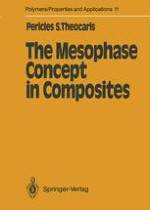The increasing use of advanced composite materials in modem structures of high performance calls for a detailed knowledge of their properties. On the other hand, these materials possessing intense anisotropy, and in some cases non homogeneity, require complicated theories based on homogeneous anisotropic elasticity. Typically, such materials either involve fiber-reinforced composites, which are stacked in layers and form laminates, or particulate composites, containing a second phase in powder form. However, each case must be separately analyzed in terms of the particular characteristics of the materials involved and the process of preparation of the com posite systems. Composite materials consisting of more than one destinct phase are in general use in modem industrial applications. Machine parts, structural components and others may be manufactured from such materials. Epoxy resins are suitable matrices for this class of materials. This is due not only to their general-properties such as linear mechanical behavior, transparency, etc., but also to the possibility of modifying their mechanical and optical properties in a very wide range by using suitable modifiers. Their rheological behavior, as well as their dynamic properties have been extensively investigated.
